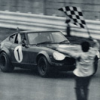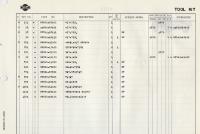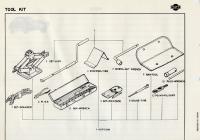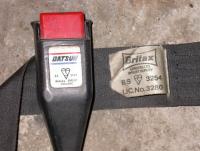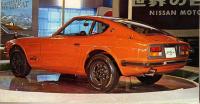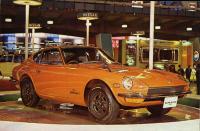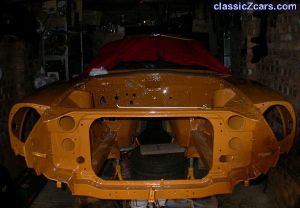Everything posted by HS30-H
-
240Z Series 1 Tool Box Questions
Sorry Mike, my R-DRIVE books only go up to 1974. However, if its any help or consolation, the illustration that applies to the Export "RS30" and "GRS30" is the same as the one I posted. Don't forget that many of the tools on that illustration were listed as "Option" parts. In my experience, that means that 99.9999% of customers buying a new Z were actually unaware that they even existed! I think the 'full' on-board tool kit is a very rare beast indeed. And if a customer specified all of those optional tools on one of the earliest cars, then I think they would surely have trouble finding enough places to store them all? Cheers, Alan T.
-
Paint Code
SiGNAL Z, What's the VIN prefix on your car? Is it "GS30" or "GS31"? If it was built in 1977 it should be an S31, and the 2/2 version had the "G" prefix on the VIN code. You might find that your paint code is 307. Alan T.
-
240Z Series 1 Tool Box Questions
Here's a scan of the relevant page that explains the part numbers and their applications. Hope it helps:
-
240Z Series 1 Tool Box Questions
-
Walter Mitty Historic Races
Hi 26th-Z, I'll have to dig out some photos of 44PHH Mikunis as fitted to Works cars then. They were pretty much exactly the same as those initially sold through Sport Corner and the Sports Option parts dealers, though. As I mentioned, the castings changed quite a lot and can be difficult to keep track of. Does he think there is something particularly special or different about them? I don't recall any specifics that would identify them as "Works" type or non-Works type, apart from some of the modified trumpets they used. The 16010-E4620 Sports Option part number seems to have been used through a fairly long period, and its hard to say what might have been different from one set to another at any particular period. That transmission part number ( 32010-E4151 ) is that of the standard FS5C71A five-speed transmission ( 19T:6T ) as fitted to all Fairlady Z-L models from 1969 onwards, and as an optional extra on the Fairlady Z from 1969 onwards too. It was also fitted to the non-USA "Export" 240Z models of HS30 and HLS30 from the beginning of production until they switched to the "B" type box ( the "option" being the 4-speed ). As such it would not have been fitted to the car as it left the Factory ( presuming it was indeed essentially a USA / North American market model bought in Japan ). Did Mike mention that it had a close-ratio gear set? I would have thought there would be a good possibility of one of the close-ratio gear sets having been purchased and fitted, given the high spec of the rest of the Sports Option parts on the car, and other fabricated race-oriented bits. It would appear that the original owner spent quite a lot of money on Sports Option parts, so a close-ratio gear set would not be out of the question ( I wonder if he got some discount?:classic: ). I'm glad that Mike does not believe the car to have been "Factory prepared" now. I think all the evidence points away from this. I'm fascinated by the story and the car's life and think its a great part of the history of the Z car. However, it seems a pity that the car is still being misrepresented at zhome.com after all the effort that has been made to track some of its true history. Are those Mike's words in the zhome write-up, or are they those of Carl Beck? The line "....is one of the earliest 240Z factory-built race cars still in existance today, and may be the only FIA car." is particularly disappointing. Its about time that was re-written. No disrespect to the car or its owner intended. Its an interesting and probably unique car in many respects, but it does not need to have any false representation of genuine Works history attached to it. I agree about the nose if that makes a difference; it looked like it was a fairly well-intended but somewhat inept attempt to streamline the car without paying attention to the race regulations ( and bumped it up into the 'wrong' class at Macau ). The Works were working on similar ideas around that time, but their efforts were always very methodically thought through and, it has to be said, very well engineered and fabricated. Isn't it great that this car still exists! All the best, Alan T.
-
Walter Mitty Historic Races
Hi 26th-Z, I'm very pleased that you have seen the car and posted some photos. I thought this story was going to be set in stone in Z history without any chance of outside input...... I had some contact with Mike Cammarata a few years ago regarding this car. I spotted it from the zhome article and attempted some research on it, as I found some of the zhome article to be pretty far fetched and somewhat speculative. Above all, I thought it seemed to include a lot of exaggeration by "Jack Pray" that was being taken as gospel truth. Mike Cammarata was very pleasant to converse with, but at that time didn't seem to know much about the Japanese side of the story other than what he had been told. Maybe things have taken a step further since then? I told him that it was EXTREMELY unlikely that this car was ever modified by the "Works" race department at Oppama, or even at Omori. The article makes it sound as though the parts fitted to the car back in the early Seventies were genuine "Works" parts, and that the car was - in effect - a full Group 4 FIA 'Works' spec car with all the bells and whistles. In fact, full 'Works' style modifications would certainly never have been performed on a 'customer' car ( especially an Export-spec car that was sold through a dealership to American service personnel ) as there was at that time no system for such a service within Nissan. Even the regional Nissan SCCN teams and top privateer racers and their teams were using hand-me-down stuff for the first couple of seasons of Japanese domestic racing. It should also be remembered that full 'Works' Nissan Z cars of that period had bodyshells that were built specifically for use as racecars, and were fairly different to the road cars in many areas. It seemed to me that most of the special parts on the car were the over-the-counter Nissan 'Sports Option' parts that were available at the time through certain dealerships, and through the Sport Corner dealership at Omori in particular. These are extremely interesting and very nice to see still fitted to the car that they were originally purchased for, but they are NOT full 'Works' competition parts, and the bodyshell itself is that of a standard road car. I also noticed some modern modifications to the car - so its lost some of its originality, possibly due to necessity in conforming with modern race safety regulations? The car is ( still ) being misdescribed in the zhome article, even though the likelihood of it being anything more than a very interesting locally-created privateer race car was put to rest quite some time ago. The Macau nose was certainly NOT anything to do with Nissan's Oppama race workshops or the Omori site, and was much more likely to have been a local garage confection ( at that time I was told that Jack Pray was stationed in Okinawa, and not Guam ). Despite searching through Japanese domestic race reports for the 1969 through 1975 period, I have yet to see evidence of a non-Japanese driver entering a first-generation Z in a race in Japan during that period, other than a couple of very interesting exceptions. Neither of these exceptions tally with the car and driver in question........... I have the Japanese race reports from the relevant Macau GP support races, and they simply mention that a privateer Z qualified but failed to get to the end of the race. Sadly there are no further details and no pictures. You can bet that if the car had been Works-connected in any way they would have had a little more to say about it. What's this about the Mikunis on the car? The earliest 40PHH and 44PHH models had their part number and model designation on a sticker attached to the main body, rather than any stamp or casting mark. Has he got 40mm or 44mm carbs? What is he measuring? I had a guy tell me that he had "48mm" Mikunis once, but he turned out to be measuring the body bore size on the inlet side.............. Mikuni PHH carbs changed in many details over the years, but the 'Works' and semi-Works teams never used any special carburettor castings that I am aware of. They are more likely to be the normal Sports Option kit from that period. Cheers! Alan T.
-
Walter Mitty Historic Races
Great photos! Many thanks for posting them and following up with some stories too. Its good to get a bit of 'background' to help with the understanding of the photos. Actually, Its kind of reassuring to see rain at an American event. I thought you had some kind of deal with the sun out there for a while:classic: Cheers! Alan T.
-
Cantelivered engine
Sean, Surely you mean 'canted' don't you? Cantilevered is quite another thing altogether I think............... Of course - as has already been pointed out - the answer is that the engine was installed at a canted angle to give lower installed height in the car. This allowed a lower bonnet / hood line and more ground clearance for the sump. Don't forget that the L-series 6 engines first fitted to the S30-series Z models - the L20 and L24 - were not designed 'for' the S30-series Z cars. They were in quite a few other models too, and some of these debuted BEFORE the Z car. Transmissions had to be 'canted' at the corresponding angle without disturbing the correct position of the gearlever, and this was achieved by using bellhousings that mated with the engine at the correct angle whilst leaving the gearchange mechanism in a suitable position. Contrast this with the S20 engine, which was pretty-much 'upright', and used a bellhousing which corresponded to that angle. The 'LY' Crossflow was another version of the L6 that was mounted at a different angle to the L20 / L24, and that too had its own bellhousing. Giving extra space & clearance for the inlet / exhaust manifolds and carbs would have been an issue that was taken into account at the design stage of the engine, but I think you'll find it was the installed height issue ( in all models ) that dictated the angled installation, much as it does on many cars today too. They could not lay it over too far though, for obvious reasons......... We could even make a side-thread about the angled installation's advantages / disadvantages in RHD and LHD layouts ( what larks Pip! ), but I doubt this would lead to anything much other than the usual stalemate. However, its well known that the layout of the L-series engines ( with inlet and exhaust on the LEFT side of the engine from viewpoint of the driver ) was an inheritance from Nissan's Austin-influenced days, and so RHD-biased............. I don't think the engine's installed angle has any impact upon its internal or external balance. Alan T.
-
California Mille photos
Great pictures Ben! Is it always sunny at your car shows over there??!! Can't you box some of it up and send it over here please?:classic: That car you are describing as a Jaguar "D Type" is in fact the XKSS model. It started life as a D Type, but Jaguar re-bodied them to sell in the USA - so it kind of is and isn't a D Type but it IS an XKSS. A guy who lives in the street behind mine here in central London has a British Racing Green XKSS which he sometimes takes out on summer Sundays. Its running open pipes with no silencers, and it knocks leaves off the trees in the street when he fires it up. Sets off all the car alarms in the street as he drives past, and even those on some of the office buildings too. Glorious! All the best, Alan T.
-
G-nosed 280...
Hi Carl, The "HLS30" VIN prefix was also used on the USA / North American market "280Z" model. Cheers, Alan T.
-
G-nosed 280...
My observations on the yellow ebay car: Vendor states: "This 280z ZZZap features a very unique feature found only on the Japanese model "Z"s. It is called the G-Nose. We are not 100% sure if the car was specially imported over here with this option. What we do know from corresponding with experts in the field is that this kit was only available during its time as a JDM (Japanese Domestic Market) item, they could be ordered with Japanese market 280z's. To replicate this item in the U.S. it would cost at minimum $4,600, excluding labor ($2,000) and paint ($3000) . The G-Nose kit includes G-Nose hood (longer than the normal hood), G-Nose fenders, G-Nose springs and hinges, G-Nose front bumper, G-Nose headlight covers, G-Nose parking & turn signal lights etc. The G-Nose isn't a conversion taken lightly on such a pure Japanese sports car. G-Nose was made and designed by the factory to improve aerodynamics, the factory quoted with the G-Nose it will improve top speed by approx 5 mph." That car could not have been specially imported with the G-Nose "option", as the Factory only fitted them to official 240ZG models and never as an "option" part. If the front end components had been purchased from the Japanese Sports Option list then the owner would have to have fitted them himself, or have somebody else fit them ( ie - not the Factory ). They could NOT be ordered with Japanese market 280Z's, as the Japanese market did not have a model called the 280Z. The ZG model was not sold after 1973 either. The hood ( bonnet ) on the ZG model is exactly the same as it is on the 'normal' Z models - so I don't know why the vendor is saying that it is longer. There is a filler panel in front of the hood which effectively makes the hood look longer......... The fenders ( wings / guards ) are also exactly the same as 'normal' ones - its just the sugar scoops / fender extensions that are longer..... The hood / bonnet hinges are different, but the springs are the same. Parking / turn signal lamps aare also the same as on 'normal' Z models, so I don't know why the vendor is stating that they are different. The G-Nose and Overfenders, and the 3-piece rear wing / spoiler are very likely to be copies or replicas of Factory items. Only close inspection would reveal the truth, but the likelihood is that they are 1980's USA-made copies and not Factory original parts. The welting underneath the Overfenders was never fitted to the ZG model, nor was it part of a fitting kit for the Sports Option parts. There seems to be some kind of slat grille in the front air intake opening, which is also a 'custom' feature, and not part of the original ZG equipment or Sports Option parts. This seems to be a very highly personalised 'Custom' car that is somewhat out of date in terms of taste. A few years ago it would have been seen as quite contemporary, but like most 'custom' jobs - time passes and tastes change. One day it will possibly come back into 'fashion' again. Until then its something of a curate's egg. It looks fairly well done, but the problem with selling such a car is that a potential purchaser has to like / appreciate the modifications and agree with the price that the vendor expects. Its much harder to sell something like this than it is to sell a known quantity such as the ZZapZ special edition model that this car is based on. Sorry to sound negative, but I think its worth correcting the auction description. I hope that nobody purchases the car thinking that they are buying something that was an official or semi-official Nissan model. Surely nobody is going to purchase it at that "Buy It Now" price anyway? Cheers, Alan T.
-
Parts Car - What parts are worth?
Hi Alan, Yes - in many ways I agree. I have always thought that the RS30 models were one of the better S30-series models, but were slated for problems that could have been easily sorted. If the RS30 model had been fitted with fuel-injection from the beginning then it would surely have inherited a better reputation. I love the earlier cars, but I've always fancied a bone-stock RS30 ( RHD ) "260Z" model as a "keeper". I also have a soft spot for the 2+2 ( 2/2 in Japan ) in bone-stock condition. I agree that these are increasingly rare, but I have noticed that they have a very loyal following and that some people ( at least here in the UK ) have been aiming at top-notch restorations on them. They will indeed be some of the rarer first-generation Z models. Over here in the UK we also saw some slightly strange HS30 / RS30 hybrids at the point of changeover, and they are always entertaining as Nissan seems to have had a somewhat ad-hoc policy in applying parts and spec. changes and in logging them accurately. Buying parts for these cars can be a little bit difficult without knowing exactly what was previously fitted. Compare this to the USA and Japanese markets, which seem to have been very well documented and 'planned'. However, I would not call the Australian / NZ / UK markets 'dumping grounds', and I would have thought it was probably more ****-up than conspiracy ( as usual! ). I also think that ALL of the first-generation RHD cars got a bit confused around the 74, 74, 75 period. I suspect that they were the victim of the big internal changes at Nissan around that time, and related to other factors such as local-market laws and the Oil Crisis etc. I agree that the figures are probably not thousands out for the Australian-market, but I reckon they might well be a few hundred out. Above all, I'm trying to make the point that we CANNOT trust any list that so blatantly ignores a whole raft of 'other' RHD Z cars. Its weird. There is STILL no definitive list of production figures that breaks down ALL markets and models. Even the Nissan Shatai figures only quote "Export" and "Domestic" versions. I'm sorry to jump in on this with hobnail boots, but whenever I see those "Datsun 280ZX" book figures being quoted as though they are gospel truth I feel obliged to point out that they are crock. Surely this is only too painfully obvious if we look at what they purport to show? Cheers, Alan T.
-
Parts Car - What parts are worth?
Those "1st generation Z car production" figures quoted on the cybersanford site seem to be the ones from the "Datsun 280ZX" book that Carl Beck quotes on the zhome site. In fact, judging from the "American Sports Car" quote and other comments I would imagine that cybersanford took a lot of inspiration from the zhome site................ "thats right, this car was designed for the U.S. market!" Its a real shame that so many people quote the figures from that book, as they are without doubt a complete crock of crap. You can quote me on that if you want. Notice that they purport to be "First Generation" Z car production figures. This SHOULD include all of the S30 / S31 models and derivatives ( S30, PS30, HLS30, HS30, RS30, RLS30, GRS30, GRLS30, S31 etc etc ) but quite clearly the quoted list misses a huge amount of production. Example: They quote a nice round "500" for USA in year 1969, with ALL other territories ( I presume "other" also includes Japan?!! ) getting zero. Sorry - but that is total rubbish. Nissan Shatai's own internal production records show that they built 543 "Export" S30-series bodies during 1969, and 969 Domestic S30-series. According to the 280ZX book figures ( quoted by zhome and cybersanford ) these 969 bodies did not exist.............. Another example: Take the 1970 year production ( not "Model Year" - I'm talking about what was MADE, not what Nissan said they sold ). Nissan Shatai's records state that they made 3,700 "Domestic" market S30-series bodies in 1970 - but the 280ZX book list shows just three cars in its "other" category for that year. The list is either right or wrong. Seeing as it seems to completely ignore Japanese domestic production and sales, I can't see how any of the other figures that it quotes as "First Generation Z car production" can be taken seriously, let alone trusted. In short, its rubbish. This is one of the things about the "Z World" that saddens me. The list purports to give accurate information about "First Generation" Z cars, without even mentioning the existence of the Japanese domestic-market models. I see a lot of this. Its like some weird form of denial. Very strange. An almost perverted perspective. Alan T. ( ps - who wants to volunteer to tell cybersanford how to spell Australia? :classic: )
-
Best looking Z you've ever seen?
Yes I agree - a 432-R or even a 'plain vanilla' 432 would surely be a most interesting addition to a US show I would have thought. That has to be a possibility for the near future? With Japanese owners bringing their cars to US events in the past ( and 2004 too? ) surely it would be a good idea to invite / sponsor at least one 432 and owner to come along? Did they get sponsored / expense-paid last time? What was the deal with that? Did Nissan pay? I noticed the stir that the red LY-engined car caused when it was brought to the Las Vegas show a couple of years ago. It would be nice if USA-based enthusiasts could hear what a nice S20 engine sounds like and what a nice complete and fairly original 432 looks like. Maybe it will even happen this year.......... :classic:
-
Best looking Z you've ever seen?
Hi Gareth, That's right - the bumper over-riders were a Factory option on the Japanese home-market cars. There were lots of other options too. Australian ( and UK - hell, even German and French! ) market cars were all pretty-highly specced from the Factory, and included 'sportier' suspensions ( harder dampers, stiffer springs ) and 5-speed transmissions. They usually came with rear anti-roll bars too. The Japanese home market probably had the best choice of Z models, specs and options overall - especially after October 1971 - "in my opinion".......... :classic:
-
Original seatbelts for 1970
Unfortunately, most of the sets that I have seen over here have been in pretty bad condition. I also would not recommend trusting your personal safety to a pair of this type of belts - with an old and slightly suspect inertia-reel mechanism. Even an old set of static belts must surely be better insurance than these?
-
Original seatbelts for 1970
The type in my picture were three-point inertia-reel type.
-
Original seatbelts for 1970
I don't know if its of any interest, but the UK market cars were subject to UK 'Type Approval' laws that - as far as I understand - dictated that the safety belts on the early Z were changed to a UK-compliant type when the cars were sold new. The officially-franchised importer ( Datsun UK LTD ) gave the job to a well-known UK safety belt manufacturer called BRITAX. BRITAX made a "Datsun" branded safety belt system which complied with the UK's then-current British Standard 3254 safety belt laws. I should imagine that the cars were shipped from Japan without belts, and that Datsun UK LTD had their dealers fit the UK-compliant belts before sale. As far as I know, at that time the UK was one of the first countries in the world to legislate on inertia-reel safety belts for new cars. Other markets were probably not far behind, though. Here's a pic of a DATSUN / BRITAX belt:
-
Best looking Z you've ever seen?
Hi kyteler, They were BRIDGESTONE "SUPER SPEED" radials. I believe that these came with the yellow lettering on them ( and the BS logo too ) and that this was not just applied for the show. My 432R replica is coming along - albeit very slowly. While the weather has been bad here I have been bringing parts home to work on them in the warm. I have parts of the car everywhere at the moment! I'm busy with other home-related stuff recently - so I just do bits and pieces as and when I get the time and energy. However, the weather has been picking up a little lately and I've been spending a few evenings laying under the body - cleaning it all up around the diff and trans tunnel area. There was still a lot of ancient underseal and Factory silver paint under there, and I've been scraping it all off. Very messy, but somehow very satisfying to get back to bare metal in those areas...... Cheers, Alan T.:classic:
-
Best looking Z you've ever seen?
-
Best looking Z you've ever seen?
Thanks to kyteler and Mike for mentioning my car. I must say that the body and the car's general exterior appearance ( apart from the wheels of course ) is exactly as it would have left the Factory with - so any plaudits have to go to Mr Yoshihiko Matsuo and his team, and the Nissan Motor Co. - rather than to me. Now I'm going to have to nominate a fave of my own. One car that has always captured my imagination, and given me an image that I can always go back to when I start to doubt what the early Z car was all about, is the Fairlady Z432 that took pride of place on the Nissan Motor Co. stand at the 1969 Tokyo Auto Show. This car was on a rotating circular platform all on its own, and Nissan considered it as the premium model amongst its new Fairlady Z range. I also like ( naturally! ) the 432-R model that debuted at the same time, as that was just so special, but the 'normal' 432 at the show just looked so good and so fresh that I have to nominate it as a fave. You can imagine that this particular car would have had a VERY low VIN number ( fun to imagine just how low it might have been..... ) and wouldn't it be nice to imagine travelling back in time and giving it a good look over?
-
progress.......
Ah I see now. I'm just using the standard Nissan nuts, bolts and screws - but cleaning them up and replating them where necessary / possible.
-
Absolutely Gorgeous Modified Z
SLEEK Z, Surely you should not be surprised to receive replies on the other websites where you are posting the same links and comments? I've seen the same thing on four websites - and that's only the ones that I peruse ( maybe there are more? ). You should watch out for anybody who calls themselves "Albrecht" anyway; they are sure to be an idiot! I think ( from my perspective anyway ) that you might be in danger of over-hyping this car. Perhaps you will not agree, but as far as I am concerned your description of the car and the way that you have 'spread the word' across the Z-related web sites over the last few days has been somewhat hyberbolic. Its a fantastic engineering achievement, and I take my hat off to Komiya san, but I DO think its underside appearance lets it down a little. Its clear that he started off with a bodyshell that had had the usual hard life of a 30-odd year old car, but I'm surprised that he did not have the underbody straightened out a little more ( especially as the pictures show the car up on stands at a car show ). I'm not talking about pure cosmetics here. My eye ( perhaps mistakenly ) sees welding and repairs to the underbody that look fairly old. If I was building a car like this I don't think I would necessarily want to trust what previous owners had thought was good enough in that department. Maybe just as importantly, I would not want anyone to make a mistake and come to the conclusion that the underbody was something I had not investigated fully and made sure that it was structurally sound and within tolerance. When you put your car up on stands like that, and people take photos that spread all over the web, then perhaps it promotes unfair scrutiny and the possibility of people picking fault with your hard work. It makes me wonder what the situation was with regard to the planning and building of the project. Did Komiya san do the work himself, or did he plan the project himself and then have the work undertaken at a pro shop ( RISING? ). No doubt you will be asking this kind of question to Komiya san in the near future. Many of the first-generation Z cars over here in the UK have been poorly repaired in the past - so I'm used to seeing welded repairs. Indeed, its sometimes possible to see cars with patches welded on top of patches! :stupid: I agree that structural integrity is more important than cosmetics when it comes to the body, and I have nothing against properly-executed repairs ( read: SAFE and STRAIGHT ) even when they are not beautiful. Personally speaking ( I consider myself NOT to be what you might call a "purist" ) I prefer to see good engineering rather than "show" finishes ( I believe some call that "bling" in your part of the world ) rather like you might see on an old race car or aircraft. However, I certainly appreciate fine skill and understand just what kind of work goes into a great paint job. In my opinion, Komiya san's car seems to display a bit of both. If it wasn't being promoted so strongly then I might not feel it necessary to point out any perceived fault. With regard to your website, UK-based Z owner Paul Henley's efforts to repair and restore his car properly are very commendable, and he has my admiration and respect. I certainly would not want you to think that I thought otherwise. Surely you know that? I have no idea what Paul plans for his car, and as its his car he can do what he likes. I certainly don't think its a good idea to try and draw some kind of imaginary line between "restorers" and "modifiers", as to my mind they have much more in common than they have differences. There's a huge grey area in between and I think people like myself are in that grey area. What is most important is integrity in engineering and practice. Everything else is just a matter of taste. Taste is subjective, and subjectivity is subjective - so it ends up as philosophy anyway! When you posted your links and comments about this car on the websites, you did expect that not everybody might agree with you about the car didn't you? Surely you don't just expect everybody to ignore certain points of the car? I think I'm making fair comment, and its certainly not with the intention of showing disrespect to the builder / owner. If I was standing in front of the car with Komiya san I think I might ask him about the points I am making on the car's underbody appearance, but also compliment him on the amazing overall job. I don't think that would be rude. Maybe my inner Robbie The Robot shouts "warning, danger!" whenever a commercial concern makes one of these kinds of posts with links to their website. In many respects SLEEK Z = zparts.com doesn't it? I'm sure you are not using this kind of post as 'bait' or 'advertorial' are you? Its a fine line and I'm sure its difficult to tread. Respectfully, Alan Thomas. London, UK.
-
Absolutely Gorgeous Modified Z
I must say, the standard of the modification / engineering is very impressive until you see the underside photos. I hope that unibody is still strong enough to cope with the power and torque that is going to be transmitted through it........ It looks a little wobbly under there to say the least....... "Fur coat and no knickers" as we say over here.:classic: Alan T. ( ps - maybe I'm just miserable because I've been laying underneath my project car for what seems like the last six months, stripping off all the 34 year old underseal and Factory paint and trying to get back to bare metal :stupid: ).
-
progress.......




